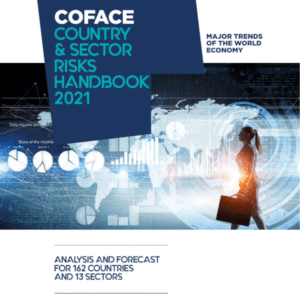As a credit insurer, our added value comes from the ability to proactively provide our clients with detailed risk analyses, allowing them to make the right decisions at the right time and prevent credit risks. Our latest Country and Sector Risk Handbook includes country and business climate assessments for 162 countries, as well as sector risk, and assessment of companies’ default rate.
Download the latest handbook

What does the handbook include?
Country risk assessment
The country assessment provides an insight into the average payment incident level presented by companies in a country in connection with their short-term trading transactions. More specifically, this assessment measures the way in which company payment behaviour is influenced by a country’s economic, financial, and political perspectives, as well as by the business
climate. It is based on three pillars: macroeconomic, financial and political analysis, business climate assessment by Coface’s entities across the world, and Coface’s payment behaviour experience as recorded in its worldwide database. The country risk assessment covers 162 countries on an 8-step scale: A1, A2, A3, A4, B, C, D, E, in order of increasing risk
Business climate assessment
This makes it possible to see whether company accounts are available and reliable, whether the legal system ensures fair and effective protection of creditors, whether the country’s institutions provide a favourable framework for B2B transactions and whether the domestic market is easy to access. The assessments are based on data from international organisations, but also, and primarily, on the experience of Coface’s entities across the world. This assessment, integrated in the country assessment, covers 161 countries on an 8-step scale: A1, A2, A3, A4, B, C, D, E, in order of decreasing business climate quality.
Sector risk assessment
Every quarter, Coface reviews the assessments of 13 sectors in 28 countries (representing approximately 88% of global GDP) in 6 major regions of the world. In order to assess these risks, Coface relies on its own methodology, which is based on three pillars and eight criteria, and has been strengthened with more quantitative criteria. The first pillar focuses on data relative to Coface’s expertise on corporate payment behaviour worldwide, in the various sectors under consideration. The second pillar concerns forecasts of processed financial data. The last pillar brings together key multifactorial criteria (evolution of commodity price forecasts, risks linked to structural changes that may occur in a sector, and country risk assessments, which have an impact on the risk assessment of a given sector in a particular country).
The criteria included in the first two pillars are summarised below.
Coface’s expertise regarding payment experience:
- Unpaid ratio level for companies of the same sector in a given country.
- Forecasts on changes in default amounts in a given sector at the global level.
- Sector risk assessment from Coface’s underwriting services.
Pillar regarding the use of corporate financial data:
- Daily Sales Outstanding (DSO).
- Analysis of quantiles for forecasts in financial data (net debt, profitability).
The sector risk assessment is on a 4-step scale: low, medium high, very high, in order of increasing risk.
Assessment of company default rate
The DRA (Debtor Risk Assessment) measures the default rate of companies all over the world. It is calculated on the basis of indicators such as financial soundness, profitability, solvency, as well as the company’s environment and management. The assessment scale ranges from 0 (company in default) to 10 (best possible rating). The DRAs are made available to Coface clients on a dedicated website: Cofanet.
Economic publications
Coface regularly publishes economic publications that deal with country risk, sector risk, and the risk of company insolvency.